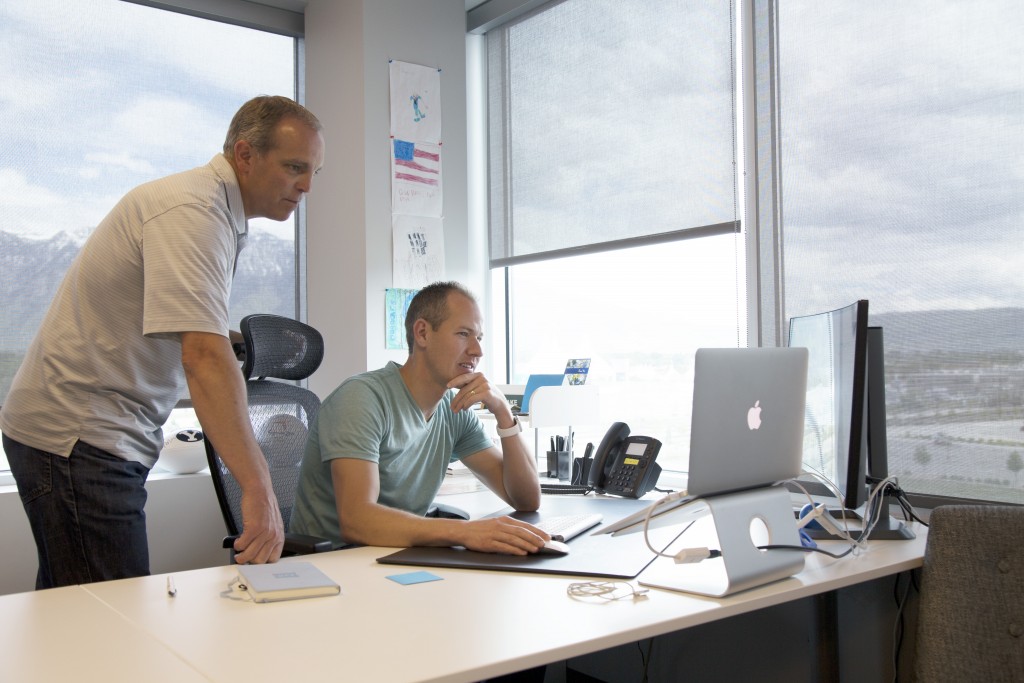Marketplace Lending
Bizfi Originates $144 Million in Q2; CAN Capital, Entrepreneur Media Launch Funding Center
August 16, 2016 Online small business loan marketplace, Bizfi said that it originated over $144 million in Q2 this year, a 25 percent increase compared to $116 million in Q2 last year. The New York-based company has facilitated financing for more than 3,580 small businesses through its platform.
Online small business loan marketplace, Bizfi said that it originated over $144 million in Q2 this year, a 25 percent increase compared to $116 million in Q2 last year. The New York-based company has facilitated financing for more than 3,580 small businesses through its platform.
The company forged many partnerships to expand its customer base and access to small businesses. In March of this year, Bizfi announced a partnership with Western Independent Bankers (WIB), a trade association with community and regional banks across the Western United States and in July, it joined hands with the National Directory of Registered Tax Return Preparers & Professionals (PTIN).
Bizfi also secured a $20 million investment from New York-based investment manager Metropolitan Equity Partners in June this year, supplementing the $65 million infusion in December last year to expand and optimize its funding programs and develop an effective marketing campaign to advertise those better.
In other news, small business lender CAN Capital and Entrepreneur Media launched the funding center offering funding products that include term loans — available from $2,500 up to $150,000 for a single location with range of terms from 3 to 36 months. Trak loans which are working capital loans available from $2,500 up to $150,000 and installment Loans provide funding from $50,000 to $100,000 with 2, 3, and 4 year terms and have fixed monthly payments.
Lend Us An Ear: Women in the Industry Speak Their Mind
August 11, 2016
The majority (52.5 percent) of employees in the banking and insurance industries are women — if this sounds strange, that’s because it is, considering only 1.4 percent eventually go on to become CEOs. While the male dominance is not apparent at the mid-management executive level, the sex ratio is rather skewed on top. Needless to say?
deBanked grabbed the opportunity to speak to three women in the alternative business financing industry, charting their journey, reliving their experience, knowledge and the lessons that got them to where they are. Here are excerpts from the interviews.
Back to Roots
For some, their careers are not a deliberate choice, but a serendipitous stumble.
Heather Francis, CEO of Florida-based Elevate Funding, who went to college to become a healthcare professional entered finance by happenstance. “I went to school for health promotion and education at the University of Florida and graduated in 2007,” said Francis, who comes from a family of entrepreneurs and is a fifth generation Floridian. “I found that the position I was looking for was not a necessity for companies, it was a luxury like setting up gyms, that people were not willing to pay for at that time.”
Francis landed her first job in finance with a private equity firm called Strategic Funding in Gainesville, Florida where she set up the firm’s merchant cash advance business. After spending seven years there, in 2014, she set up Elevate Funding which in a short span of 16 months has made over 1,000 advances to businesses.
For Kabbage Loans cofounder Kathryn Petralia too, fintech was a far cry from wanting to be an English professor. A graduate from Furman University, Petralia’s tryst with finance was when she got roped into a project, valuing companies using data compression tools. Riding on building her tech expertise, she founded her first company at 25 which made store catalogues digital. “I was a kid and did not know anything about marketing or sales, so I ended up selling the startup to the company which helped me build it.” The venture however gave her an in into finance and she went on to work for Revolution Money and eventually built Kabbage Loans.
But for Danille Rivelli, VP of Sales at United Capital Source, however, the jump wasn’t as big or unusual. Although finance was not originally on her mind as an art major, it was a natural path from what she began doing to acquire real-world work experience during school, selling mortgages. Rivelli changed her academic focus and went on to get a business degree from Briarcliff College, where she also played on the softball team.
“A year or two into college, I started doing mortgages, making 5 percent commissions. It was natural and it just kinda flowed,” said Rivelli whose first job out of college was on the sales floor at Merchant Cash Capital, now Bizfi. “I wanted to get out of mortgages and I was hooked when I saw the sales floor, it was fun and upbeat.” She was also one of the company’s youngest salespeople at the time.
Women Can Do No Wrong. Or Can They?
When we asked what women need to do differently at workplaces? The answer was quick, resounding and not surprisingly – be more assertive.
“Women think from the heart more than the mind,” said Rivelli. “I find myself in situations sometimes where I know that I should be ‘leaving the emotions out of it’ so that I’m not second-guessing myself as much.” But it’s what helps her build lasting relationships with clients. “I think most effective sales people will agree that the most important part of our job is listening. You want to really know and understand who your client is and what they’re looking for before you try to sell to them.”
According to Petralia, who thinks of herself as ‘one-of-the-guys,’ the problem lies in overplaying the differences between men and women. “I think we perpetuate the stereotype that men are supposed to behave a certain way and women aren’t. I notice that when men crack a joke or use a curse word, they immediately apologize to the women in the room. We are making that happen,” she said. Petralia’s strategy in such scenarios is to swing to the other side and initiate banter. “I am very comfortable with dirty jokes and f-bombs.”
“Men are really good at faking it ’til they make it. They position themselves as experts when they are not but women are unsure of jumping into the deep end when they are not sure they can swim and that’s a big part of what we have to overcome,” Petralia said.
Francis is on the same page, “Men have no problem tooting their horn, but women don’t do that. We cannot expect anyone to stand up for us. If you think you’re getting looked over for a promotion, walk up to your boss and say it,” she said. Francis talks about most of the struggle being personal rather than operational. “I will admit to us having a need to be right… right about decisions, right in arguments and right about where the furniture goes,” she says jokingly. “A lot of what led me to start Elevate was my belief in that you could service the risky credit market without taking advantage or putting insane demands on the performance of the portfolio and still be successful… having that theory validated and accepted and in the end, being right.”
What’s the hurdle, what’s the race?
And the assertiveness comes from one’s belief in their struggle and the value of that struggle. Petralia reminisces of a time when as a scrimping 25-year-old entrepreneur, she pitched a tent and stayed on a campsite in San Francisco while raising money for her startup. Two decades later, she runs a billion dollar lending company. Petralia recognizes that not all women have the same opportunities.
“When I was raising money for Kabbage, I realized that I had only been in one or two meetings where a woman wasn’t bringing me water,” said Petralia who believes that bringing diversity requires work and companies should set targets and find qualified diverse candidates.
Kabbage allows for 12 weeks of maternity leave but that pales in comparison with other countries, says Petralia. “The problem with women is, we have the babies. Women have to choose between their careers and personal life and we are not even close to making that situation better. The key time in their 30s when they are having kids, they come back to compete with younger people who are cheaper.”
The movement to make it better, according to her should begin with creating a system of incentives like better child care, easy commute to work etc. where women don’t have to choose between advancing their career and having a child.
And her other gripe is limp handshakes from men. “Shake women’s hands better. Men give this limp, deadfish like handshake at conferences to women and it’s the worst.”
According to Francis, equal footing comes from striving for professional equality and representation. She says being a woman opens many doors but that’s where it stops. “People will talk to you nicely if you’re a woman but they don’t think you are the person making the decision. You have the ability to start the conversation but no one thinks that you can finish it.”
And for Rivelli, that means giving it your all. “The point is to keep being so good that no one can ignore you,” she said.
Bloomberg’s Cory Johnson Reads Between the Lines On Lending Club
August 8, 2016Fifteen out of Lending Club’s top twenty investors have returned to the platform since the May scandal albeit at lower levels, said Lending Club’s CEO Scott Sanborn. Bloomberg News’ Cory Johnson said that the other way to read this is that a quarter of their investors have refused to come back.
Meanwhile, company CFO Carrie Dolan was still on the earnings call despite having announced her resignation moments before. Referencing the use of investor “incentives” to get investors to come back, Dolan explained that the company still anticipated higher investor acquisition costs going forward. Johnson said that this could mean for a long time, putting even more pressure on a company that has slim margins to begin with.
Watch the short clip with Johnson below:
Video not loading? View here
Lending Club Q2: CFO Resigns, Originations Shrink, Huge Losses
August 8, 2016 Another earnings, another resignation. This time, it’s CFO Carrie Dolan who will be replaced in the interim by the company’s corporate controller Bradley Coleman.
Another earnings, another resignation. This time, it’s CFO Carrie Dolan who will be replaced in the interim by the company’s corporate controller Bradley Coleman.
In Q2, the company netted a loss of $81.4 million, compared to $4.1 million a year ago. The shocking increase is partially attributed to a $35.4 million write-down of Springstone’s Goodwill, the patient financing company they acquired two years ago. Meanwhile, professional service fees increased by $14.9 million as a result of all the lawyers and auditors required to handle the recent scandal. During the Q&A, Company CEO Scott Sanborn explained that such professional service fee related work were not one-time costs and would continue to an extent.
“Our efforts to reengage investors are working, with fifteen of our top twenty largest investors back on the platform today,” said Sanborn in a statement. However, it was unclear as to whether or not those investors will buy at the same levels as before and the five who haven’t returned were unnamed so the supposed rebound in confidence remains vague.
Retail investors remained fairly resilient, investing over $327 million in Q2, up 16% year-over-year. With 135,000 active individual investors, that means the average retail investor invested a little under $2,500 on the platform during the quarter.
Originations shrank from $2.75 billion in Q1 to $1.96 billion in Q2.
The company still managed to have $832 million in cash on its books and is therefore in a relatively strong position to escape its current problems.
OnDeck, Lending Club to Announce Earnings Today
August 8, 2016 Both OnDeck and Lending Club are scheduled to host their Q2 earnings calls today At 5 PM EST.
Both OnDeck and Lending Club are scheduled to host their Q2 earnings calls today At 5 PM EST.
For Lending Club, investors will have an opportunity to assess the damage that rocked the company in May. Back then, the sudden resignation of the CEO was brought on by a loan manipulation scandal and conflicts of interests. That led to a DOJ Grand Jury investigation that was compounded by a New York Department of Financial Services subpoena in an unrelated probe. The ensuing appetite to buy their loans waned, forcing Lending Club to use their own balance sheet to ensure the flow of their business went on uninterrupted. On July 28th, CEO Scott Sanborn announced that they were NOT becoming a balance sheet lender and were holding only 2% of their expected quarterly loan volume. More recently, investment bank Jefferies is said to have sold $105 million in bonds backed by Lending Club loans, showing signs that confidence in the company’s product remains.
OnDeck isn’t embracing the tech company characterization as much as they used to. Earlier in the year, CEO Noah Breslow described the company as a “non-bank commercial lender” in an interview on CNBC. As such, origination growth at the expense of all else is no longer likely to excite investors who have shifted to judging the company on its path to profitability and its long term plan to sustainability. In Q1, they were asked what would happen if the company stopped the marketplace aspect and just held all its loans on balance sheet. The response? More short term losses, due to accounting standards. Two things investors will surely be looking at is the cost of marketing in Q2 in the face of increasing competition and loan performance.
How Lendio Reached $250 Million in Funded Transactions On Its Platform. Hint: Partnerships
August 5, 2016 Utah-based marketplace Lendio said that it has help facilitate over $250 million in funding transactions on its platform to over 10,000 small businesses. $55 million was originated in Q2 alone.
Utah-based marketplace Lendio said that it has help facilitate over $250 million in funding transactions on its platform to over 10,000 small businesses. $55 million was originated in Q2 alone.
Lendio’s partnerships have been paying off. Deals with GoDaddy and Staples originated $14 million and $4 million, respectively in Q2 of this year.
Last month (July 21), the company joined hands with digital marketing firm Townsquare Media in cross-promoting products and services. The company has also been pushing the SMART Box initiative spearheaded by the Innovative Lending Platform Association.
“As leaders and stewards in this industry, we feel it is imperative to rally around a common ground of best practices so the responsible flow of capital to Main Street continues and expands,” Blake added. “Providing business owners with the most complete information is one way to make sure that happens.”
Marlette Closes Proprietary Securitization Deal Worth $205 Million
August 3, 2016After a personal-loan bond sale last month, marketplace lender Marlette Funding closed its first proprietary securitization worth $205 million. “MFT” consists of Best Egg collateral financed via three classes of Notes and one class of Certificates.
Best Egg is Marlette’s personal loan platform with $2 billion in originations since 2014. This transaction, done through Goldman Sachs was the second securitization of unsecured consumer loans originated by Cross River Bank on the platform. In July, Marlette securitized personal loan bonds worth $180 million in Single A notes rated by Kroll Rating Agency.
This news comes at a time as online lenders and marketplaces alike feel the need to diversify sources of capital. “Accessing the securitization markets represents the third major component of a diversified funding plan, which also includes building strong relationships with institutional investors and developing on-balance sheet asset backed credit facilities,” said Paul Ricci, CFO of Marlette Funding.
Hold The Loans Or “Marketplace”? It Depends
August 1, 2016
At the risk of stating the obvious, the motivation to keep loans on balance sheet or sell them off through a marketplace is related to the type of lending one does. But even then, opinions on the best strategy varies. Is there a winning formula?
Not all online lenders are marketplaces. Some consumer lenders like Affirm, for example, hold all the loans they issue on their balance sheet. Avant, another consumer lender, has either held all or some of the loans on its balance sheet, making it a kind of hybrid.
But for companies like Lending Club, long considered to be the definition of marketplace, their May debacle showed the weakness that model can have, at least with those lending to consumers.
Interest rates, terms and risk profiles associated with businesses are different from those for retail consumers. According to Fora Financial co-founder Dan Smith, this changes the economics of the game since consumer loans are typically longer (3-5 years) compared to business loans where the weighted average term could be as short as under 12 months. This, not only makes consumer lending a lot more capital-intensive it also begs for diversification of sources.
“When I started the business, I had one lender in 2007 and they said they couldn’t work with us. Today, my credit facility has eight different lenders,” said Stephen Sheinbaum, founder of Bizfi which buys future receivables with its balance sheet in addition to running a loan marketplace. “We are undoubtedly seeing a shift from the B2C side. Any model that has sources of funds concentrated in one area is risky.”
Relying on your own balance sheet can lead to handsome returns, sources say. Sheinbaum, said that his company can make twice as much by holding than gains on sale. For companies engaged in consumer lending, that margin can be anywhere between 5 percent to 20 percent depending on borrower profiles and the type of loans, said student lender CommonBond CEO David Klein.
The unit economics of assuming risk can be higher if risk is assessed well. “If you do it well, balance sheet lending provides better unit economics,” said Fora Financial’s Smith. “You have to have the right capital structure, a low cost of capital and need to be able to underwrite effectively so it can scale.”
Smith however warned that this is not prescriptive and consumer lending companies like Lending Club might be forced to take a multi-pronged approach given the barriers to entry and the regulation around balance sheet lending for consumer loans. “There is clearly a more significant regulatory environment to get into on balance sheet consumer lending and that might be a barrier to entry.”
Often referred to as ‘having skin in the game,’ balance sheet lending potentially forces companies to assess risk better and be scrupulous about underwriting. But marketplaces whose prerogative may be seen as trying to make as many loans as possible, will inevitably be scrutinized over perceived conflicts of interest in their underwriting.
There are arguments to be made for each of the models but a better case is made for hybrid models which aims to take the best of both. Klein of CommonBond, said that his company leans heavily on balance sheet at times and the marketplace at other times. “Unless your investors are broad in profile and deep by type, then it is possible for a loan sale purchaser to walk away.” Klein said. “It all comes down to control. If you have more of it, there’s less risk.”
While more consumer lenders gravitate towards hybrid models, Lending Club at the end of Q2 held only 2 percent of the loan volume on balance sheet and CEO Scott Sanborn is very clear about the company operating purely as a marketplace.
“Some of our investors have observed the funding environment and asked: Are you going to become a balance sheet lender, just like a regular bank? Has Lending Club’s business model changed?”
“Let me be very clear: Lending Club is committed to the marketplace model and we do not plan to become a balance sheet or ‘hybrid’ lender. Our mission of connecting borrowers and investors has not changed,” wrote Scott Sanborn in a letter to investors.
The letter reiterated that the limited use of balance sheet does not affect Lending Club’s Notes. And while the company soldiers on, Lending Club’s story has taught many lessons to other lenders.
“In the wake of Lending Club’s news, you realize that if you have a hiccup on the way, it’s good to control some of your capital and assets because if you are truly marketplace, a hiccup in investor confidence can meaningfully change their trajectory,” said Klein who believes that for a pure marketplace player to survive, it needs to have more retail investors than institutional investors.
And there seem to be more people who agree than disagree. “The B2C model of selling 100% to a secondary market will cease and fault,” said Sheinbaum. “If buyers go away, your entire model is jeopardized. In a perfect world you want options. You see whichever way the wind is going and you try to go with it.”
The challenge then is in telling which way the wind will blow and be prepared for a storm.





























